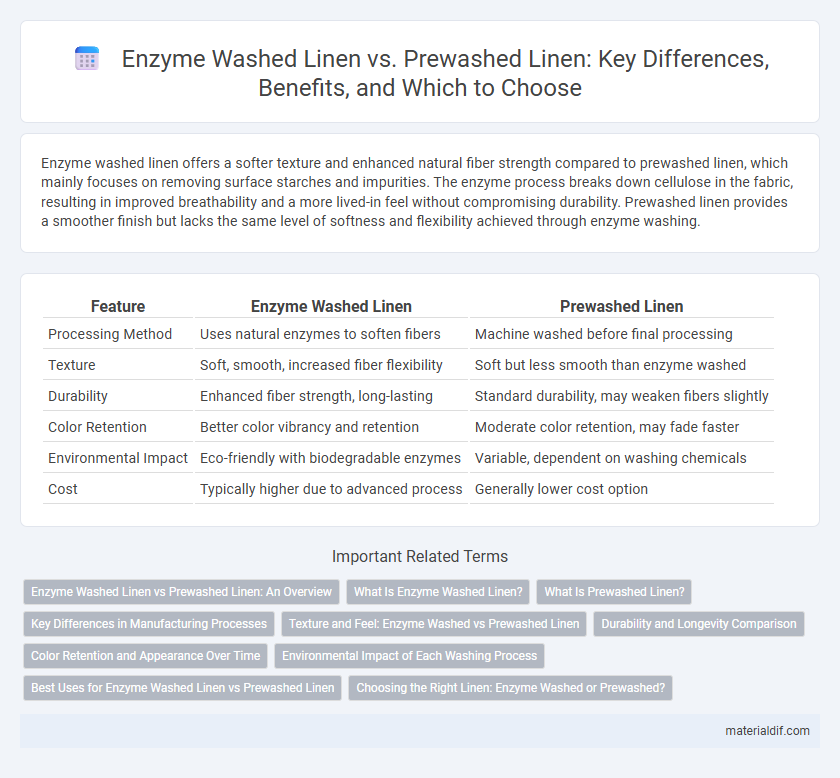Enzyme washed linen offers a softer texture and enhanced natural fiber strength compared to prewashed linen, which mainly focuses on removing surface starches and impurities. The enzyme process breaks down cellulose in the fabric, resulting in improved breathability and a more lived-in feel without compromising durability. Prewashed linen provides a smoother finish but lacks the same level of softness and flexibility achieved through enzyme washing.
Table of Comparison
| Feature | Enzyme Washed Linen | Prewashed Linen |
|---|---|---|
| Processing Method | Uses natural enzymes to soften fibers | Machine washed before final processing |
| Texture | Soft, smooth, increased fiber flexibility | Soft but less smooth than enzyme washed |
| Durability | Enhanced fiber strength, long-lasting | Standard durability, may weaken fibers slightly |
| Color Retention | Better color vibrancy and retention | Moderate color retention, may fade faster |
| Environmental Impact | Eco-friendly with biodegradable enzymes | Variable, dependent on washing chemicals |
| Cost | Typically higher due to advanced process | Generally lower cost option |
Enzyme Washed Linen vs Prewashed Linen: An Overview
Enzyme washed linen undergoes a biological treatment process using natural enzymes to soften fibers and enhance fabric texture without compromising durability, resulting in a smoother, more refined finish compared to prewashed linen. Prewashed linen is mechanically washed before production to reduce shrinkage and improve softness but may retain a stiffer texture than enzyme washed variants. The enzyme washed process not only improves softness and reduces pilling but also maintains linen's inherent breathability and moisture-wicking properties, making it highly desirable for premium textile applications.
What Is Enzyme Washed Linen?
Enzyme washed linen undergoes a specialized treatment using natural enzymes that gently break down the fabric's fibers, resulting in a softer texture and a more relaxed, worn-in appearance. This process enhances the fabric's breathability and drape, making enzyme washed linen ideal for comfortable, lightweight clothing and home textiles. Unlike prewashed linen, which is simply rinsed to remove impurities, enzyme washing specifically targets cellulose in the fibers to create a uniquely smooth and refined finish.
What Is Prewashed Linen?
Prewashed linen undergoes an initial wash process at the textile mill to soften fibers and reduce shrinkage before cutting and sewing. This treatment enhances the fabric's texture, making it more comfortable and easier to care for compared to untreated linen. Prewashed linen is less prone to wrinkles and maintains its durability, providing a ready-to-use feel without the need for extensive post-purchase washing.
Key Differences in Manufacturing Processes
Enzyme washed linen undergoes a bio-treatment where specific enzymes break down the fibers, resulting in a softer texture and reduced pilling. Prewashed linen is mechanically washed to remove starch and impurities, enhancing its breathability and diminishing shrinkage. The enzyme wash uses biological agents for fiber modification, while prewashing relies on traditional laundering methods to prepare the fabric.
Texture and Feel: Enzyme Washed vs Prewashed Linen
Enzyme washed linen offers a softer, smoother texture due to the targeted breakdown of fibers by enzymes, making the fabric feel more delicate and lightweight. Prewashed linen provides a slightly coarser, more textured feel with a natural, lived-in softness that enhances durability and maintains some of the fabric's original structure. Both treatments improve linen's comfort, but enzyme washing emphasizes softness while prewashing preserves a robust, classic linen hand.
Durability and Longevity Comparison
Enzyme washed linen undergoes a process that softens fibers while maintaining strength, resulting in fabric with enhanced durability and resistance to wear over time. Prewashed linen is treated to remove shrinkage and impurities, offering immediate softness but sometimes compromising fiber integrity, which may reduce longevity. Choosing enzyme washed linen typically ensures a longer-lasting fabric that withstands frequent use and washing better than prewashed alternatives.
Color Retention and Appearance Over Time
Enzyme washed linen undergoes a controlled enzymatic process that softens fibers while enhancing color retention by removing excess dye trapped in the fabric, resulting in a rich, consistent hue that resists fading over time. Prewashed linen, treated with simple washing techniques, offers immediate softness but may show quicker color fading and a more worn appearance due to less effective dye stabilization. Comparing both, enzyme washed linen maintains vibrant color and smooth texture longer, making it ideal for products requiring durability and sustained aesthetic appeal.
Environmental Impact of Each Washing Process
Enzyme washed linen uses natural enzymes to break down fibers, reducing chemical usage and lowering water pollution compared to traditional methods. Prewashed linen involves multiple wash cycles with synthetic detergents, leading to higher water and energy consumption and increased chemical runoff. Enzyme washing offers a more eco-friendly approach by minimizing environmental waste and promoting sustainable textile processing.
Best Uses for Enzyme Washed Linen vs Prewashed Linen
Enzyme washed linen offers a softer texture and a more natural, worn-in look, making it ideal for casual clothing, home textiles, and lightweight summer apparel. Prewashed linen provides enhanced durability and reduced shrinkage, which suits structured garments, upholstery, and items requiring firm fabric integrity. Choosing enzyme washed linen benefits comfort and a relaxed aesthetic, while prewashed linen excels in maintaining shape and longevity in heavier use.
Choosing the Right Linen: Enzyme Washed or Prewashed?
Enzyme washed linen offers enhanced softness and a smoother texture by breaking down fibers during processing, making it ideal for delicate garments and home textiles. Prewashed linen ensures minimal shrinkage and a natural, lived-in feel with retained durability, perfect for everyday use and heavy-duty applications. Choosing between enzyme washed or prewashed linen depends on the desired fabric softness, shrinkage control, and long-term wear characteristics required for your project.
Enzyme Washed Linen vs Prewashed Linen Infographic

 materialdif.com
materialdif.com